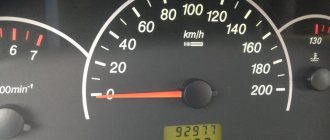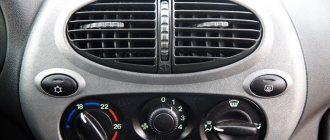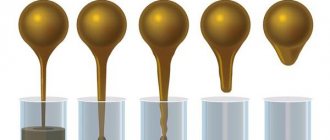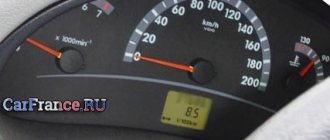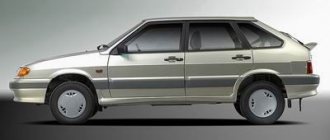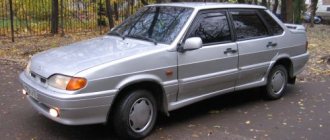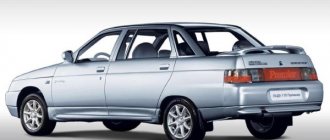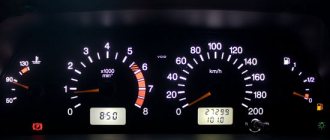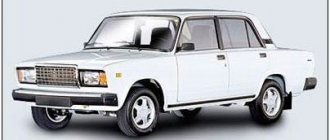Absolutely all Lada Kalina owners are interested in such an indicator as the fuel consumption of their car, and surely each of us wants to make it less. But there are many owners who even dream of factory performance.
The video above shows that the instantaneous consumption of my 8-valve Kalina at a speed of 100 km/h is no more than 5.8 liters, provided that the car has winter tires and the car is almost fully loaded. There is no catch there, AI-92 gasoline, I’m driving on a flat but very good road, I think that with summer tires the numbers would be even lower.
So, over my entire driving experience of 8 years and the total mileage on all my cars is at least 300,000 km, I have several comments and opinions about what can affect fuel consumption and how to moderate the engine’s appetite. This is my personal opinion and I do not impose it on anyone and do not insist that this is 100% true, but judging by my experience, everything was exactly like that.
[custom_ads_shortcode3]
Real fuel consumption Kalina 2 (hatchback and station wagon)
If we look at the technical characteristics of the new Kalina, we will see that “ Fuel consumption by driving cycle, l/100 km ” is indicated as follows:
- Kalina 2 manual transmission hatchback spends 10.5/6.1/7.8 liters in the urban/suburban/combined cycle in the “standard” and “norm” configurations.
- Kalina 2 station wagon manual transmission requires 10.4/5.9/7.6 liters in the urban/suburban/mixed cycle in the “standard” and “norm” configurations.
We decided to analyze the reviews of the owners, as a result of which a table of gasoline consumption was compiled, according to which we can say that the real gasoline consumption of the Lada Kalina 2 (1.6 liters, 87 hp manual transmission) is as follows:
- Consumption in the city ranges from 8l/100km to 10l/100km. The average is 8.6l/100km.
- Consumption on the highway ranges from 5.8 l/100 km to 8 l/100 km. The average is 6.5 l/100 km.
- The combined cycle ranges from 7l/100km to 8.5l/100km. The average is 7.5 l/100 km.
The fuel consumption of Kalina 2 with automatic transmission (luxury) is significantly higher, the declared gasoline consumption is 12.2/6.3/8.5 in the urban/suburban/combined cycle, in practice we received the following figures:
- Highway 6.5 - 7.5l/100km. The average is 7l/100km.
- City 10.3 - 13.2l/100km. The average is 12l/100km.
Why do different owners have such a wide range in numbers? Fuel consumption may vary due to a number of reasons:
- Seasonality . Everyone has noticed that in winter, gasoline consumption is much higher than in summer. This is due to slippery roads, tires, warm-up, etc. From observations, it was noted that warming up the new Kalina in winter increases fuel consumption by 2 liters.
- Gasoline quality . Gasoline consumption is affected not only by the octane number (by the way, AvtoVAZ recommends refueling Kalina 2 only with 95AI), but also by the quality of gasoline. From the calculations of the owners, it was concluded that the average consumption on 95 gasoline is less than on 92, and upon calculation it turned out that it is cheaper to drive 95AI.
- Traffic jams. If one lives in a small city and does not know what traffic jams are, and the other in a metropolis stands idle in them for hours, then the consumption of a Lada Kalina in city mode for these two car owners will be completely different. For reference: even a small traffic jam can increase gasoline consumption by 2 liters.
- Driving style. If the calm nature of driving keeps gasoline consumption figures within normal limits, then active driving with sharp braking and acceleration can increase consumption significantly!
- Air conditioner. When the air conditioner is turned on, Granta consumption increases by 1 liter.
- Malfunctions of Kalina 2 . And of course, the reason for high gas consumption may be problems in the car itself. In this case, you should make a diagnosis and fix the problem.
By the way, read about the consumption of the 1st generation Kalina. In the comments you can leave your data on gasoline consumption on the new Kalina (City/Highway/Mixed/Gasoline/Season/Driving Style):
Photo source:
The ECU on Kalina is filled with antifreeze - what to do?
After the block filled with antifreeze has been removed, its initial inspection should be carried out. For these purposes, it is necessary to remove 4 screws using a star screwdriver. Then you should slowly remove the control board for a visual inspection. The most common failure is the burnout of the ignition coil output switch. In this case, repair will not help.
As a result of such a malfunction, the Lada Kalina starts working on only 2 cylinders, and sometimes refuses to start at all. You can cope with a similar problem in a stationary workshop. There they will remove the damaged element, wash and dry it. The second most common problem is board burnout. It is not difficult to detect such a defect: the characteristic blackening of the board will leave no doubt.
Is it possible to repair the ECU in this case? The answer to this question can only be given by a service center, but experience shows that repairs will not help here. A complete replacement is required. It happens that sometimes the brain circuitry is slightly damaged. If this happens, then the car owner can get off easy. To restore the car to working order, you will need some minor repairs:
- wipe the block with a dry cloth;
- rinse with WD-40 several times and blow it out with a compressor;
- rinse several times in alcohol and blow again with a compressor;
- dry well, otherwise the Lada Kalina will not move;
- drying takes at least 1-2 hours.
Real fuel consumption of Lada Kalina (according to reviews from car owners)
Many car owners of the Lada Kalina passenger car complain that in reality, gasoline consumption indicators differ from those specified by the manufacturer. For comparison, let’s look at another information table prepared by specialists taking into account feedback from Lada Kalina car owners.
Lada Kalina, 1.4 l
When comparing two information tables, it is clear that the real figures are indeed higher than the stated factory fuel consumption standards for the Lada Kalina. What are the reasons for this discrepancy between the figures?
The main reasons for the difference between the gas consumption figures for the Lada Kalina passenger car - real and factory ones
There are several reasons for the discrepancy between the actual gasoline consumption figures of the Lada Kalina and the factory standards. Experienced car enthusiasts identify typical ones among them:
- Type of terrain - driving in the city, on the highway, off-road or mixed type of road (the more complex the type of road, the higher the fuel consumption).
- The driver's driving style is slow driving, fast driving, with sharp acceleration, with sharp braking (the more complex the driving style, the higher the gas consumption).
- The quality of the fuel used - AI-95 gasoline is consumed less than AI-92 gasoline.
- Time of year - in winter, fuel consumption rates will be higher, this is affected by icing of the road surface and frequent warming up of the vehicle itself.
- Traffic jams - due to slow driving and frequent braking, gasoline consumption increases by almost several liters.
- Using additional car devices (for example, air conditioning) – with devices constantly on, gasoline consumption will be 0.5-1 liter more.
In addition to the reasons listed, fuel consumption can be affected by various breakdowns of the vehicle itself:
- incorrect readings of the electronic engine control system due to sensor errors - temperature, mass air flow, oxygen, throttle position;
- abnormal pressure in the fuel system;
- internal combustion engine injector malfunction;
- failure of the catalyst;
- dirty air filter.
To install them, the car owner needs to diagnose the Lada Kalina passenger car. After diagnosing and identifying the causes of malfunctions, the vehicle is repaired.
Functional features
The main purpose of the sensor discussed here in Lada Kalina is to measure the main parameters in the intake system and adjust the speed. This is done by sending pulses to the engine control module, which, based on the data received, adjusts the volume of injected fuel.
Due to the fact that the specified idle speed regulator acts as an actuator, determining its failure is a very difficult task. This is due to the lack of a useful self-diagnosis function in the Lada Kalina.
The device is designed to control the volumes of air that are directed through the intake tract into the combustion chambers of the engine. Here, the air mass (also measured by the mass air flow sensor) enters through a special channel, bypassing the throttle valve, which is closed in idle speed mode.
This idle speed regulator is involved in warming up the 8-valve engine, ensuring that the unit reaches its operating temperature in a timely manner.
When the ignition is turned on, a rod “crawls out” from the regulator and reaches a specially designed hole. This is called the initial position of the sensor.
Next, we outline the primary functions of this device:
- adjusting the optimal air mass;
- participation in warming up the engine 8 valves;
- determination and adjustment of the number of revolutions.
Low or uneven tire pressure
But if you guarantee that the car has not been overloaded, you drive in the most economical manner possible, the car does not have any additional bells and whistles like a baby carrier or a roof rack, but there is still an overrun, then diagnostics are needed to identify the cause of the malfunction. Absolutely all Lada Kalina owners are interested in such an indicator as the fuel consumption of their car, and surely each of us wants to make it less.
How to save fuel with a VAZ injector?
As for the injector, here things are much more complicated. The fact is that electronic devices that may not work correctly are responsible for the fuel supply. Therefore, if you notice too much fuel consumption, carry out diagnostics; perhaps one of the sensors is not working correctly. Cleaning the injectors and checking them for leaks also helps a lot. In case of leakage, the nozzle must be replaced.
Another problem with system malfunction is firmware. It makes sense to try reprogramming the controller. In skillful hands, the controller can switch the engine to the most economical operating mode.
What does fuel consumption depend on? First generation
2007, so lately I have been noticing high fuel consumption in urban conditions, the drive to work does not take long, 5-7 minutes of warming up, it comes out to 13.6 liters, the data from the flow sensor coincides with the fuel measurements. So, over my entire driving experience of 8 years and the total mileage on all my cars is at least 300,000 km, I have several comments and opinions about what can affect fuel consumption and how to moderate the engine’s appetite.
| Modification | Consumption city, l/100 km | Route, l/100 km | Combined cycle consumption, l/100 km | Acceleration, sec up to 100 km/h |
| VAZ-11180, 5-speed Manual transmission | 9,8 | 6,1 | 7,8 | 13 |
| VAZ-21126, 5-speed Manual transmission | 9,4 | 5,8 | 7,2 | 12 |
| VAZ-21126, 4-st. Automatic transmission | 9,9 | 6,1 | 7,6 | 12,5 |
| VAZ-21127, 5-st. Manual transmission | 8,6 | 5,6 | 6,7 | 11 |
| VAZ-21127, 5-st. Automatic transmission (robot) | 8,6 | 5,6 | 6,7 | 11,2 |
Method #2: Choose travel times according to traffic conditions.
Essentially, when stuck in traffic, your car travels the entire distance in first gear. But fuel consumption rises not only due to the fact that your engine is not running properly. You get very high consumption when starting the car from a stop - more energy is spent on this than when moving evenly. Plan your activities according to the traffic situations. Nowadays, everyone can afford to install applications that display traffic congestion. Use this and save not only fuel, but also time. If you have things to do that are not tied to weekdays, then why not save them for one day off? If you can get to work an hour earlier, why not spend time at work instead of stuck in traffic? If you are puzzled by this, you can save a lot of time and fuel by avoiding traffic jams.
Practice time management on the roads!
Lada Kalina 2004 - 2013 Gasoline quality
| Lada Kalina fuel consumption per 100 km: automatic transmission, manual transmission You must wait until the fuel reserve light comes on, fill the Kalina until the tank is full, save the receipt and reset the daily mileage counter. This is due to the fact that some drivers do not recognize the established framework for optimal driving of a Lada Kalina car, which significantly affects fuel costs. |
| Lada Kalina: fuel consumption, characteristics The video above shows that the instantaneous consumption of my 8-valve Kalina at a driving speed of 100 km per hour is no more than 5.8 liters, provided that the car has winter tires and the car is almost fully loaded. the hatchback has a body with 1-2 rows of driver and passenger seats, with a shortened rear overhang, hence the name hatchback means shortened and a smaller luggage compartment, equipped with a lift-up door in the rear wall;. |
- gasoline quality;
- technical condition of the engine and transmission;
- driving style;
- terms of Use;
- tire pressure;
Features of fuel consumption on the Kalina • The video above shows that the instantaneous consumption of my 8-valve Kalina at a speed of 100 km per hour is less than 5.8 liters.
Technical condition of the Kalina engine
During the break-in stage, the Lada Kalina engine tends to heat up more than in normal mode. This is explained by an increase in friction between the mutually moving components of the cylinder-piston group. The result of this is an increase in fuel consumption. A similar result will be demonstrated by a car whose engine “suffers” from oil starvation or lack of quality lubricant. This aspect should be taken into account, since modern Kalina engines are prone to increased sensitivity to the quality of the oil.
It is very rare for a new car to upset the owner with any malfunction. Another situation is replacing the ECU firmware. The factory software has settings that provide for a running-in mode for the power plant and its further operation under average conditions.
Some owners of Lada Kalina saw at this moment the fact of an increase in fuel consumption. Particularly desperate owners of Kalina “pour” new firmware into the “brains” of their cars, designed to reduce consumption.
Also, a catalyst that has become unusable can provoke the engine to increase in “gluttony.” The consequence is the formation of carbon deposits on the components of the cylinder-piston assembly, which subsequently causes combustion of the mixture in an incomplete volume. The engine “says goodbye” to adequate dynamics, and the on-board controller screen immediately indicates to the owner an increase in consumption.
A similar situation is observed when the mass flow sensor malfunctions. This is accompanied by the occurrence of errors in the motor control module. To avoid such an unpleasant circumstance, you will need to tend to replacing the air filter component more often.
We would like to draw the attention of those who like to install luggage compartments on the roof. In this case, one can observe a deterioration in the aerodynamic properties of the car, which inevitably leads to an increase in gasoline consumption
A few words about the suspension. Faulty components also provoke an increase in consumption. Unadjusted brake pads and unlubricated bearings will “ask” the owner to visit gas stations a little more often.
New bodies and engines
A considerable proportion of owners are prone to driving at high speeds and aggressive driving style. Fuel consumption inevitably increases, and the face of the temperamental driver becomes covered with surprise, turning into despondency.
Low or uneven tire pressure
I think it’s no secret to anyone that not only the maneuverability and behavior of the car on the highway, but also the fuel consumption of your Lada Kalina depends on the pressure in the wheels. Before filming this video, which is located above, I drove 140 km to the village: so then, at the same speed, the consumption was about 6.5 liters on the same section of the road, but the right front wheel was lowered to 1 atmosphere, here is a real example of this , why did my Kalina eat more then?
Naturally, in winter on a snowy road, the needle on the gasoline gauge will tend to zero faster than in dry weather and on summer tires. Heavy snow or rain, wind - all this negatively affects fuel consumption, as they create enormous resistance to the car body. In winter, of course, you have to spend even more money on gasoline, since you have to constantly warm up the engine.
How to tighten the electric power steering rack?
The appearance of a knocking sound in the operation of the electric power steering is associated with the need to tighten the steering rack.
How to do it right:
- First you need to disconnect the battery; to do this, disconnect the terminals from it. Unscrew the battery mount; to do this, you need to unscrew two more nuts located at the edges. After this, the battery is removed and put aside.
- Then you need to lift the plastic stand, there are four more screws under it, they can also be unscrewed.
- Having done this, it is necessary to move this stand forward until the platform is disconnected from the air filter housing retainer pad. After this, the trim can be moved back, this will provide freer access to the rail itself.
- At the next stage, you will need to crawl your hand under the rail. Directly below it, as shown in the photo, there is a rubberized cap; it will need to be removed, this will allow the key to access the adjusting nut.
- To perform adjustment work, you will need a special wrench to tighten the rack; without it, the adjustment procedure will not be possible. Using this wrench, you need to crawl under the car rail to install the tool in the required hole.
- When adjusting, be careful not to overtighten the rack. If its tightening is very strong, then when cornering the rack will bite, and this, in turn, may affect the safety of movement. The angle of adjustment is always different, it depends on how much the nut is loose, but usually when performing such work the nut is tightened by approximately 30 degrees. This should be enough to get everything right. After the adjustment is completed, it will be necessary to check that this task was performed correctly. That is, you will need to make sure that the steering wheel turns normally to any position all the way and there is no knocking. If the knock remains, then the adjustment continues.
Photo gallery “Adjusting the steering rack”
1. Slide the stand and detach it.
2. In this place under the rail there is an adjusting washer.
3. Adjustment is made with a special key.
4. Location of the adjusting nut.
First generation
And there are many other technical reasons that will tell the service about the condition of spark plugs, filters, oil level and quality, unregulated automation, a dead battery, the list goes on for a long time. The consequence of increased consumption may be increased wear of the elements of the power unit, which can lead to unplanned overhauls.
Method #7: The radius of your car's wheels
Thanks for subscribing!
Large radius wheels, especially when they are driven, create additional resistance when accelerating the car. With a large radius of the wheel, it travels a greater distance per revolution of the engine. In this case, the travel time does not change (when starting off). But, as you know, in nature nothing comes “out of nowhere” - such movement is compensated by increased consumption. If you want to install “cool” wheels, then be prepared to pay for it not only when purchasing them.
Driving style, operating conditions and tire pressure • First cars
| Tips and ways to reduce fuel consumption on a Lada Kalina An injector, due to dirty fuel or water in the fuel, or wear and tear and basic aging, can reach a state where its mechanical part begins to leak excess fuel when the injector is closed. During the winter season, fuel consumption rates will be higher; this is affected by icing of the road surface and frequent warming up of the vehicle itself. |
| Lada Kalina: features of fuel consumption, how it is Absolutely all Lada Kalina owners are interested in such an indicator as the fuel consumption of their car, and surely each of us wants to make it less. If you want to reduce fuel consumption as much as possible, then use a simple rule: do everything possible to keep the brake pedal in one position. |
- Peter, Tyumen. I bought a Lada Kalina Cross in 2015. This is one of the few representatives of the domestic automobile industry with horsepower exceeding one hundred. And indeed the car turned out to be lively; my hatchback can compete with some foreign cars when driving on open sections of the road. The other side of the coin is gasoline consumption in the city; I did not observe the promised 8.4 liters both during the run-in and after it. This engine consumes at least 10 liters per 100 km of road with traffic jams.
- Lev, Voronezh. My wife does not know how to use a manual transmission, so I had to buy a car with an automatic transmission system. The choice fell on the second generation Lada Kalina 2014. Naturally, I understood that, as with any automatic, fuel consumption would be higher than with a manual, and that’s what happened. My figures in the city, judging by the on-board computer data, are usually within the range of 11-12.5 liters per 100 km of traffic. This sad moment worsened three years after the purchase, the injector with nozzles became clogged, for some reason this happens more often on the 8-valve Kalina than on other engines.
- Taras. Moscow. I never regretted buying Kalina Cross for my baby; she often helped me out in situations when more expensive foreign cars failed. And when breakdowns happened, and this happens, the repairs did not cost me much at all. Of course, it cannot be considered a plus that the Lada Kalina has fuel consumption per 100 km, with a power of 106 hp. higher than foreign cars of the same class. In my case, in the city, I fill at the rate of 12 liters, but on the highway the situation changes dramatically and costs drop to 7.5 liters.
- Ilya, Odessa. For a car with such a price, many disadvantages are forgiven, but they exist. First of all, this is the fuel consumption of the Kalina; it can sometimes be compared with the performance of some SUVs. Regular failure of components and parts is also somewhat annoying, but the main thing for me is road noise. Compared to foreign cars, you feel as if you are driving without doors. Of course, there are also advantages: it is inexpensive to service and parts are always easily accessible.
- Andrey, Nakhabino. I don’t understand why people have so much hatred for the Lada Kalina, because you can find out everything about it before buying, and there are plenty of disadvantages, but there are also advantages. Mostly they complain about high gasoline consumption, but you can always install LPG and save money. The metal on the body is good and thick, its quality cannot be compared with Chinese tins. It’s just a pity that the quality of the factory paint is rather weak, and over the years bubbles appear in some places.
DMVR sensor malfunction
This problem was on my previous VAZ 2112 car, where this mass air flow sensor constantly sent an error to the on-board computer and the instantaneous flow increased immediately from 0.6 to 1.3 liters per hour when the engine was idling. I had to constantly reset the error. So keep an eye on and replace the air filter more often than written in the operating instructions, thereby you will extend the life of the mass air flow sensor for many years.
Post edited by Dove: 08/21/2010 - 20:02
- true alchemist.
- Group: Users
- Posts: 3,027
Dove (Today, 11:46) wrote: check the iron, adjust the valves, use a gas analyzer to check the real composition of the mixture and the quality of combustion, if everything is OK, then it’s not the engine Aleshka87 (Today, 14:30) wrote:
- Five thousand meter
- Group: Users
- Posts: 24,413
peskovvs (Yesterday, 21:57) wrote: Iron - in the sense of sensors?
- ordinary user
- Group: Users
- Posts: 227
Dove (07/23/2010 - 10:26) wrote:
- recently on the forum
- Group: Beginners
- Posts: 3
Dove (07/22/2010 - 10:46) wrote: for a 1.6 engine, 8 valves, 9 and even 10 liters in the city is normal, on the highway mine eats, depending on the movement, - 5.9/7.1 liters per hundred.
- ordinary user
- Group: Users
- Posts: 227
- true alchemist.
- Group: Users
- Posts: 3,027
Dove (07/23/2010 - 11:26) wrote:
- Five thousand meter
- Group: Users
- Posts: 24,413
So I got my hands on the diagnostic equipment. These are the errors generated by the controller:
P0117-Low signal level of the coolant temperature sensor circuit P0102-Low signal level of the mass air flow sensor circuit P0171-Fuel supply system is too lean at its maximum enrichment P0171-Fuel supply system is too lean at its maximum enrichmentThe first error, as far as I remember, popped up during the service before last. along with an error in turning on the cooling fan. The servicemen changed the fan relay (although I knew about the problem and had changed the relay myself shortly before). They told me about the last error at the last maintenance, suggesting an air leak.
Attached is a log of the trip made by the kwp program, if it can provide additional information. I can make another log tomorrow.
- At work
- Group: Users
- Messages: 22,035
- Five thousand meter
- Group: Users
- Posts: 24,413
Yuri Petrovich (Today, 20:52) wrote: They also told me about this at the last maintenance. But the consumption was then normal. What is the reason for the high consumption?
DMRV died? Or are errors 102 and 171 related?
PS. By the way, with the suction, how do you find the place of the suction?
- true alchemist.
- Group: Users
- Posts: 3,027
Dove (Yesterday, 21:22) wrote: by ear, pinching the vacuum hoses, pouring water, water or carburetor cleaner on suspicious joints, multiplicative correction 1.24 all the way in the plus, 100% suction
- Five thousand meter
- Group: Users
- Posts: 24,413
peskovvs (07/28/2010 - 00:00) wrote: OK, we'll look for a leak.
peskovvs (Today, 01:00) wrote: That is. with the engine running? And if the engine operating mode changes, then look for the problem at this junction?
I'm posting the second log. Today, by the way, the dzhekichen has not been burning since the morning, although I did not throw it off yesterday. I also reset the tripcomp and at the end of the trip it showed an average consumption of 7.7 liters, which is already normal. And the dzhekichen caught fire again, the moment of switching on is visible on the log. Post edited by Dove: 07/28/2010 - 09:23
- At work
- Group: Users
- Messages: 22,035
- Five thousand meter
- Group: Users
- Posts: 24,413
Yuri Petrovich (Today, 16:45) wrote: Yes. It seems like there are no viburnums without a cathode collector (excluding those modified with a crowbar).
- At work
- Group: Users
- Messages: 22,035
- true alchemist.
- Group: Users
- Posts: 3,027
- Megatheronosaurus
- Group: Users
- Posts: 5,366
peskovvs (28.07.2010 — 23:44) wrote:
- ordinary user
- Group: Users
- Posts: 193
Dove (07/22/2010 - 10:46) wrote:
- true alchemist.
- Group: Users
- Posts: 3,027
glob (Yesterday, 23:16) wrote:
this is due to neglect and “old age” - for example, the air flow sensor was killed by oil, dust and high mileage, the injectors were filled with low-quality fuel (with water or something else), the filter was defective - it was torn. I doubt that a relatively “fresh” viburnum will suffer from the same bunch of malfunctions, it has its own problems , for example with a catenary collector (see above)
Method #10: Electrical Appliances
Since the generator is driven by the engine, savings can be achieved by reducing the cost of operating electrical appliances. Before installing powerful speakers in your car, think about the energy costs. After all, electricity is created by the same fuel that powers your car. Also, you can save a lot of money by installing new lights on your car. Incandescent lamps consume a large amount of energy, but, as you know, traffic rules require the use of lights while driving. An alternative in the form of daytime running lights with diode lamps is an excellent opportunity to reduce current consumption, and as a result, fuel.
Equipment – Brief description
| 23 real ways to reduce car fuel consumption Therefore, the mixture entering the combustion chambers is highly purified, which increases the efficiency of the entire system and reduces the likelihood of engine breakdowns. , with his grimy colleague, who all his life consumed only ordinary 95, and even without any cleaning abilities, then the effect may turn out to be exactly this. |
| How to reset fuel consumption on a viburnum? Special equipment However, after a detailed and lengthy discussion of the problem, many motorists agree that increased fuel consumption is a subjective concept and depends on many factors. The main reason for greater efficiency with increased power is better efficiency when consuming the fuel-air mixture, speeding up the process of supplying fuel to the cylinder and the exit of exhaust gases. |
- consumption within the city is 8 liters, but in reality – more than ten liters;
- on a highway outside a populated area: the norm is 6 liters, and owners report that the figures reach 8 liters;
- with a mixed driving cycle - 7 liters, in practice the figures reach ten liters per 100 km.
